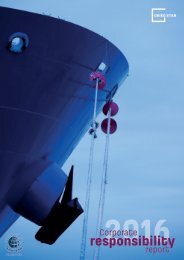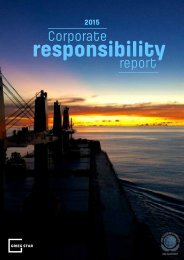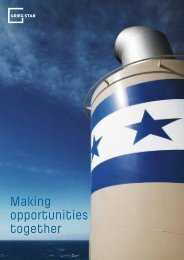You also want an ePaper? Increase the reach of your titles
YUMPU automatically turns print PDFs into web optimized ePapers that Google loves.
Note 1<br />
Accounting Principles<br />
The annual accounts have been prepared in accordance with the<br />
Norwegian Accounting Act and generally accepted accounting<br />
principles.<br />
Subsidiaries<br />
Subsidiaries are posted in the company accounts applying the cost<br />
method. The investment is stated at historical cost of the shares<br />
unless a write-down has been necessary. The investment is written<br />
down to fair value when the reduced value is due to causes which<br />
are not deemed to be temporary. Write-downs are reversed when<br />
the grounds for the write-down no longer exist.<br />
Dividends and other distributions are recognised in the year in<br />
which they are provided for in the accounts of the subsidiary. If<br />
the dividend exceeds the profit after the acquisition, the surplus<br />
amount represents repayment of the capital investment and the<br />
distributions are deducted from the amount of the investment in<br />
the balance sheet.<br />
Investment in joint ventures and associated companies<br />
Owner interests in joint ventures are stated applying the gross<br />
method. The shares of income, costs, assets and liabilities are<br />
incorporated in the accounts, line for line. The figures are specified<br />
for each main group in a note to the accounts. Investments in<br />
associated companies are stated according to the cost method in<br />
the company accounts and according to the equity method in the<br />
group accounts.<br />
Operating revenues<br />
Operating revenues are entered as income at the time of delivery.<br />
The time of delivery is understood to mean the time of transfer<br />
of risk and control related to the delivery. Freight revenues from<br />
voyages are recognised on the basis of the number of days the<br />
voyage lasts.<br />
Classification and valuation of balance sheet items<br />
Current assets and current liabilities relate to items which mature<br />
within one year from the date of purchase. Other items are classified<br />
as fixed assets/long-term liabilities.<br />
Current assets are valued at the lower of historical cost and fair<br />
value. Current liabilities are carried at nominal value at the date<br />
of issue. Fixed assets are valued at historical cost, but are written<br />
down to recoverable amount in the event of impairment which is<br />
not deemed to be temporary.<br />
Long-term liabilities are carried at the nominal amount at the<br />
establishment date.<br />
to sell and value in use. For the purposes of assessing impairment,<br />
assets are grouped at the lowest levels for which there are separately<br />
identifiable cash flows (cash-generating units).<br />
The Group’s open hatch vessels are sailing in a pool which is<br />
marketed and operated by <strong>Grieg</strong> <strong>Star</strong> Shipping AS. This means<br />
that the operational use of the vessels, including optimization of<br />
routes, is combined for the fleet. Earnings of each individual vessel<br />
is therefore affected by the earnings of other vessels in the pool.<br />
The open hatch fleet is therefore considered to be the cash-generating<br />
unit.<br />
Vessels, other than open hatch vessels, are managed within the<br />
Group’s bulk activities. Thus the dry bulk vessels are considered to<br />
be the cash generating unit.<br />
New building contracts are included in the fleet impairment and<br />
unpaid instalments are deducted.<br />
Non-financial assets other than goodwill which have been impaired<br />
are reviewed for possible reversal of the impairment at each date.<br />
Fixed assets<br />
Fixed assets are valued at historical cost less accumulated depreciation.<br />
Depreciation is charged on a straight line basis over<br />
the remaining expected useful life of each asset adjusted for the<br />
residual value. If changes in the depreciation plan occur the effect<br />
is distributed over the remaining depreciation period.<br />
Improvements are capitalised and depreciated in pace with the<br />
asset involved. Docking costs are capitalised and depreciated over<br />
the period to the next scheduled dry-docking. Depreciation of the<br />
docking is classified as an operating expense.<br />
The recoverable amount of an asset is measured whenever there is<br />
an indication than an asset may be impaired, written-down and the<br />
asset is stated at the lower of the recoverable amount and the cost<br />
price less any write-down. The write-down is reversed when the<br />
grounds for the write-down no longer exist.<br />
New building contracts<br />
Instalments on new building contracts are capitalised as new<br />
buildings and/or accounts receivables either short og long term as<br />
they are paid. Capitalised value is reclassified from new buildings<br />
to vessels upon delivery from the yard. Borrowing costs that are<br />
attributable to the construction of the vessel are capitalized as a<br />
part of the vessel.<br />
The recoverable amount of an asset is measured whenever there is<br />
an indication that an asset may be impaired, written-down and the<br />
asset is stated at the lower of the recoverable amount and the cost<br />
Intangible assets<br />
The cost of intangible assets is posted in the balance sheet if it is<br />
considered likely that the future economic benefits related to the<br />
assets will accrue to the company and a reliable measurement of<br />
the historical cost of the asset in question has been established.<br />
Asset impairments<br />
Assets that are subject to depreciation are reviewed for impairment<br />
whenever events or changes in circumstances indicate that<br />
the carrying amount may not be recoverable.<br />
An impairment loss is recognised for the amount by which the<br />
asset’s carrying amount exceeds its recoverable amount. The<br />
recoverable amount is the higher of an asset’s fair value less costs<br />
GRIEG STAR<br />
<strong>2014</strong><br />
12<br />
ANNUAL REPORT







